Safety and environmental preservation are today at the heart of the concerns of cities, faced with complex challenges. The quest for effective solutions to address these crucial issues is often hindered by significant obstacles. Among these obstacles, the lack of financial and human resources are at the forefront. Another major challenge lies in the difficulty of efficiently collecting and analyzing the data generated by these infrastructures. Cities, responsible for managing diverse public spaces, are often overwhelmed by a constant flow of information from surveillance cameras, environmental sensors, and other sources. This data overload can make informed decision-making laborious, creating a pressing need for solutions that simplify and optimize the analysis process.
Safety and environment, two major challenges
Computer vision is emerging as a major lever to push the limits of visual perception by computer systems. At its core, it enables machines to understand, interpret, and react to visual information, transcending mere image capture. In this dynamic technological landscape, the CORE platform is emerging as a solution that fully exploits advances in computer vision to address a myriad of challenges in the urban environment.
By connecting to communities' camera networks, this technology becomes the eye that detects otherwise imperceptible details. To illustrate its impact, let's examine various use cases. In the road safety field, it enables detection of infractions such as illegal parking, wrong-way driving, and running red lights, offering automated and proactive traffic surveillance. In environmental matters, it revolutionizes waste management by identifying illegal dumps, optimizing public lighting based on usage, thus contributing to the sustainability of urban spaces.
Beyond these aspects, computer vision plays an essential role in citizen safety and public space security. It detects unusual gatherings, monitors prolonged presences, and rapidly identifies critical situations such as abandoned baggage, disturbances, or fire outbreaks.
Towards intelligent city management: data analysis
Whether it's security officials or elected officials, data concerns a multitude of profiles responsible for community development. Each of these actors plays a crucial role in optimizing operations, and requires quantified and qualified data.
All data captured by artificial intelligence is automatically fed into a dashboard and enables analysis of situations to anticipate them and take related measures. Thus, citizens' safety is optimized, traffic management anticipated, and land management optimized. All thanks to data!
CORE, an ethically proven solution already deployed in over 50 cities
The CORE platform is already deployed in over 50 cities, including Massy, Poissy, and Suresnes. These cities have seen significant gains in terms of safety and environment.
The city of Massy, in Essonne, deployed XXII's CORE computer vision platform in 2019. This innovative solution allows the city to improve the mobility and safety of its residents. CORE provides a better understanding of traffic flows, with vehicle counting and classification. This data is used to improve public transport management and develop sustainable mobility solutions. CORE also allows the community to reduce security risks in the city. The platform detects obstructive parking, such as vehicles parked on sidewalks or in front of fire truck exits. It also detects gatherings, which can be signs of public order disturbances. Massy is the perfect example of the good use of our floating licenses. Depending on the day and political issues, the community diverts its licenses to analyze specific events. The results obtained by the city of Massy with CORE are tangible.
The city of Poissy, in Yvelines, has also deployed XXII's computer vision platform. This innovative solution allows the city to address security and environmental challenges. CORE allows the city to detect possible intrusions in the Town Hall, and to detect incidents of obstructive parking, such as vehicles parked on sidewalks or in spaces reserved for disabled persons. The platform is also used for counting heavy goods vehicles circulating in the city.
CORE also reduces energy consumption by automatically controlling public lighting. The platform analyzes street and park usage data to determine where lighting should be turned on or off. Suresnes is a test city where this project is in development, in partnership with Qognify.
At XXII, we do not analyze personal data: we distinguish silhouettes that we associate with an object category (human, dog, car, bicycle...) without ever using biometric data. Beyond object categorization, some of our data processing has analysis and optimization purposes (assembly line, mobility flow analysis...). In our algorithmic analyses, numerous data, including personal data, can be considered as being in a "dormant" state. They are captured by the camera but do not enter the artificial intelligence analysis scheme. To learn more, click here.
Computer vision is therefore a promising technology that offers many advantages for communities. It can be used to improve safety, mobility, waste management, and environmental protection.
